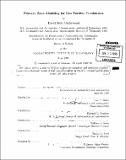| dc.contributor.advisor | Ian A. Waitz. | en_US |
| dc.contributor.author | Underwood, David Scott | en_US |
| dc.contributor.other | Massachusetts Institute of Technology. Dept. of Aeronautics and Astronautics. | en_US |
| dc.date.accessioned | 2006-05-15T20:23:11Z | |
| dc.date.available | 2006-05-15T20:23:11Z | |
| dc.date.issued | 1999 | en_US |
| dc.identifier.uri | http://hdl.handle.net/1721.1/32700 | |
| dc.description | Thesis (Sc.D.)--Massachusetts Institute of Technology, Dept. of Aeronautics and Astronautics, 1999. | en_US |
| dc.description | "June 1999." | en_US |
| dc.description | Includes bibliographical references (p. 107-110). | en_US |
| dc.description.abstract | Gas turbine combustor primary zone flows are typified by swirling flow with heat release in a variable area duct, where a central toroidal recirculation zone is formed. The goal of the research was to develop reduced-order models for these flows in an attempt to gain insight into, and understanding of the behavior of swirling flows with combustion. The specific research objectives were (i) to develop a quantitative understanding and ability to compute the behavior of swirling flows with heat addition at conditions typical of gas turbine combustors, (ii) to assess the relative merits of various reduced-order models, and (iii) to define the applicability of these models in the design process. To this end, several reduced-order models of combustor primary zones were developed and assessed. The models represent different levels of modeling approximations and complexity. The models include a quasi-one-dimensional control volume analysis, a streamline curvature model, a quasi-one- dimensional model with recirculation zone capturing (CFLOW), and an axisymmetric Reynolds averaged Navier-Stokes code (UTNS). The models were evaluated through inter-comparison, and comparison with experiment. Following this evaluation, CFLOW was applied to a lean-premixed combustor for which three-dimensional Navier-Stokes solutions existed. These simplified analyses/models were able to capture the features of swirling flows with heat release across flow regimes of interest in gas turbine combustors, provide insight into the underlying physics, and yield guidelines for design purposes. Cross-comparison of the reduced-order models highlighted the aspects of these flows that need to be described accurately. Specifically, modeling of the mixing on the downstream boundary of a recirculation zone is crucial for accurate computation of these flows, with both Reynolds stresses and bulk transport across the interface being accounted for in order to capture recirculation zone closure. The simplified mixing and heat release models used had limitations arising from the need to input empirically-derived parameters. Calibration of these parameters with higher-fidelity computations and experiments allowed comparison of the models across the flow regimes of interest. Following calibration of the mixing and heat release models, CFLOW was able to compute recirculation zone volumes to within 25% of those given by both the axisymmetric and three-dimensional Navier-Stokes codes for swirl ratios between 0.5 and 1.0 and equivalence ratios between 0.0 and 0.8. | en_US |
| dc.description.statementofresponsibility | by David Scott Underwood. | en_US |
| dc.format.extent | 135 p. | en_US |
| dc.format.extent | 6113301 bytes | |
| dc.format.extent | 6119026 bytes | |
| dc.format.mimetype | application/pdf | |
| dc.format.mimetype | application/pdf | |
| dc.language.iso | eng | en_US |
| dc.publisher | Massachusetts Institute of Technology | en_US |
| dc.rights | M.I.T. theses are protected by copyright. They may be viewed from this source for any purpose, but reproduction or distribution in any format is prohibited without written permission. See provided URL for inquiries about permission. | en_US |
| dc.rights.uri | http://dspace.mit.edu/handle/1721.1/7582 | |
| dc.subject | Aeronautics and Astronautics. | en_US |
| dc.title | Primary zone modeling for gas turbine combustors | en_US |
| dc.type | Thesis | en_US |
| dc.description.degree | Sc.D. | en_US |
| dc.contributor.department | Massachusetts Institute of Technology. Department of Aeronautics and Astronautics | |
| dc.identifier.oclc | 45241885 | en_US |
